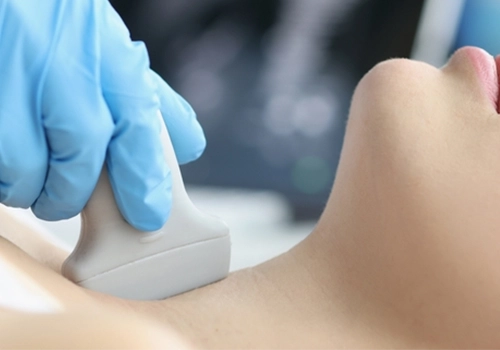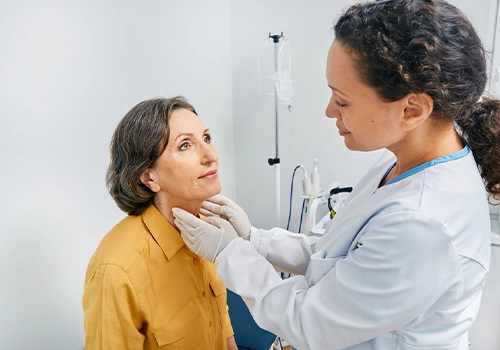Thyroid Cancer
It is essential to note that the presence and occurrence of these symptoms do not necessarily indicate cancer, and readers of this article should understand that self-examination by non-specialists should not cause them unnecessary fear and anxiety.
On the other hand, it should be remembered that with the current medical advancements worldwide, there are chances of treating various types of cancer, and like in the past, there is no room for excessive concern. However, taking timely action facilitates the treatment process.
Cancer occurs when abnormal cell growth in the body becomes uncontrolled. This abnormal activity can initiate and spread in any organ of the body. Thyroid cancer is one of the common types of cancer that originates from the thyroid gland, where thyroid cells undergo uncontrolled growth.
Changes in the size or shape of the thyroid gland can lead a doctor to suspect thyroid cancer and proceed with further tests. It’s worth mentioning that not every change in the shape of the thyroid gland indicates thyroid cancer, and specialized tests and further examinations are necessary to ensure its presence.
Enlargement of the thyroid gland can also result from other factors, such as iodine deficiency and inflammation caused by Hashimoto’s disease.
Thyroid cancer is three times more common in women than in men. Often, the tumors or nodules detected are benign and, thanks to advances in the field of medicine, this condition is largely treatable, especially when the disease is diagnosed early and cancer has not spread to other parts of the body.
The thyroid gland is like a small butterfly and is located in front of the neck. This gland is responsible for regulating metabolism and the body’s energy production, secreting hormones that have significant effects on bodily functions. If there is a disruption in the function of these hormones, various problems in the body’s heat production and oxygen consumption occur.
thyroid cancer is among the common cancers in both women and men and can be observed at various ages, although its occurrence is more common after the age of 30, and its prevalence significantly increases in middle age.
H2: The Nature of Thyroid Cancer and Its Symptoms
Thyroid cancer symptoms can vary among individuals. Below, we discuss some common signs that may indicate the possibility of thyroid cancer:

- The first and most common sign of thyroid cancer in the body is the presence of a lump in the person’s neck. It is crucial to emphasize that the presence or development of any neck lump does not necessarily mean cancer, and this should not cause undue concern. Instead, it is regarded as a warning sign for further examination.
Any lump found on your neck that does not resolve on its own within a few weeks can be a symptom of thyroid cancer. The presence of nodules in the thyroid area is common, with statistics indicating that 65% – 68% of the world’s population has thyroid nodules.
However, most of these thyroid nodules are benign and do not pose any problems for individuals throughout their lives, allowing them to carry on with their lives normally.
The prevalence of this type of cancer is more noticeable in adults. As age increases, the likelihood of developing thyroid nodules also increases. By the age of 75, nearly 80% of people develop thyroid nodules, but fortunately, less than 1% of all thyroid nodules are malignant and cancerous.
- Voice Changes: The nerves and vocal cords located behind the thyroid gland mean that any change in the thyroid gland, including swelling, can affect the voice, and both the individual and those around them may notice this change.
- Swallowing Difficulties: In the presence of a lump and thyroid cancer, individuals may experience swallowing difficulties. If any throat swelling or swallowing problems are observed, further investigations and tests are necessary.
- Breathing Problems: In the advanced stages of this cancer, symptoms such as shortness of breath, a feeling of chest heaviness, and chest pain can be counted among the signs of the disease.
Diagnosis of Thyroid Cancer and Its Types
Thyroid nodules can be diagnosed through routine examinations or X-ray evaluations. Four types of thyroid cancer are recognized as the most common types of thyroid cancer:
- Papillary Thyroid Cancer or Mixed Papillary/Follicular Thyroid Cancer:
This is the most common type of thyroid cancer, encompassing 85% of thyroid cancers. It originates from follicular cells and, fortunately, tends to grow slowly. With early diagnosis, most individuals with this type of thyroid cancer can be successfully treated.
- Follicular Thyroid Cancer:
The growth rate of cells in this type is slightly higher than papillary thyroid cancer. It accounts for about 15% of all thyroid cancer cases. There is a likelihood of its spreading to lymph nodes and possibly blood vessels.
- Medullary Thyroid Cancer:
This type of cancer arises from C-cells, which naturally make up a group of cells in the thyroid. It accounts for approximately 3% of all thyroid cancer cases. Given that this type of cancer is hereditary and genetic, it is advisable for the relatives of patients who have had this form of cancer to undergo medical examinations.

This proactive approach can help detect any potential risks before any infection occurs, allowing necessary precautions to be taken for those at risk of developing the disease.
- Anaplastic Thyroid Cancer:
Anaplastic thyroid cancer originates from follicular cells, which are crucial thyroid cells. Often, these cancerous cells have a very high growth rate and tend to spread to other areas. Treating this type of thyroid cancer is more challenging compared to other types, and unfortunately, there is limited success in its treatment.
Fortunately, only 1% of thyroid cancer cases are of this type. Anaplastic thyroid cancer is the most aggressive type as it invades other parts of the body.
Patients with anaplastic thyroid cancer, unlike other thyroid cancer patients, require chemotherapy and radiation therapy. After the removal of the thyroid, the patient no longer has a thyroid gland to produce thyroid hormones, so they must take levothyroxine tablets for the rest of their lives to prevent metabolic and body function disruptions.
The good news is that most thyroid cancers are treatable, and if you have one of these types of cancer, rest assured that thyroid cancer treatment is generally more definitive compared to other cancers.
Diagnosis of Thyroid Gland Cancer:
The diagnosis of thyroid cancer is typically carried out through a biopsy, involving the insertion of a needle into the thyroid nodule. After the biopsy, the sample is sent to a specialized laboratory where experts examine it under a microscope and perform necessary specialized tests. Fortunately, in 95 to 99 percent of cases, the tests indicate a benign condition, with only 1 to 5 percent of nodules being malignant.
- Additionally, ultrasound imaging is recommended as part of the diagnostic process to allow the physician to assess and diagnose the mass with greater clarity.
- It’s worth noting that this evaluation should not be limited to the thyroid gland alone; a thorough examination of the neck’s lymph nodes is necessary to determine the extent of the disease.
- Thyroid cancer often presents with no specific symptoms, making early detection more challenging compared to other cancers.

- It can be diagnosed either when a person seeks medical attention due to symptoms or during routine physical examinations or other diagnostic tests.
- Sample Collection:
Definitive diagnosis of thyroid cancer involves sample collection, where a number of cells are extracted from the suspicious tissue and examined under a microscope. If your physician deems sample collection necessary, the simplest way to determine whether a thyroid nodule is cancerous or not is through fine-needle aspiration (FNA), which is typically performed in a doctor’s office or clinic.
- Imaging:
Imaging may be performed for various reasons, including aiding in the diagnosis of suspicious tissues that may be cancerous. The goal of imaging is to gain insight into the extent of cancer progression in the body and assist in its treatment.
- Sonography (Ultrasound):
Sonography uses sound waves to capture images of different parts of the body.
- Radioactive Iodine Scan:
A radioactive iodine scan can be used to determine the presence of thyroid cancer in the neck or to assess the progression of thyroid cancer in individuals who are currently suffering from different types of thyroid cancers (papillary, follicular, or anaplastic). Since thyroid cancer cells do not absorb iodine, radioactive iodine scans are not used in this type of cancer.
- Chest X-ray:
If you have thyroid cancer, particularly follicular thyroid cancer, a simple chest X-ray may be performed to determine whether the cancer has spread to your lungs or not.
Other diagnostic tests and methods include CT scans, MRI, positron emission tomography (PET) scans, blood tests, thyroid-stimulating hormone (TSH), T3 and T4 thyroid hormones, thyroglobulin, calcitonin, and carcinoembryonic antigen (CEA).
Treatment of Thyroid Cancer
When we examine the prevalence of various types of this disease in different individuals, it should be noted that both papillary and follicular thyroid cancers, which constitute the majority of this type of cancer, are more common in patients under the age of 50.
However, with appropriate treatment, over 98 percent of those afflicted with this type of thyroid cancer have a chance of recovery, and their cancer can be successfully treated.

Both types of thyroid cancer, papillary and follicular, are treatable by complete removal of the cancerous thyroid lobe. In the course of treating a thyroid gland with cancerous nodules, or when several nodules are present on both sides of the thyroid, or when cancer has spread to the lymph nodes, the thyroid gland must be completely removed.
In the case of benign thyroid cancer treatment, removing the affected area can control and treat the disease. This method is not definitive, but it can be used if the swelling causes difficulty in swallowing, or breathing, or affects the neck’s aesthetics.
However, in the treatment of malignant thyroid tumors, after eliminating cancer cells, radioactive iodine therapy must be employed. This method is usually used for women after menopause. Surgery is also considered as another treatment option. It should be noted that after surgery, the use of radioactive iodine therapy is essential to eliminate any remaining cancer cells.
Decisions regarding treatment, based on the type and stage of thyroid cancer, may require the use of more than one treatment method. Briefly, the treatment options for thyroid cancer can include:
- Surgery
- Radioactive iodine therapy
- Thyroid hormone therapy
- External beam radiation therapy
- Chemotherapy
- Targeted therapy
Often, two or more treatment methods are employed simultaneously. It’s worth noting that most thyroid cancers are treatable, especially if they have not spread to distant parts of the body.
If the cancer is not treatable, the goal of treatment may be to eliminate or destroy the cancer as much as possible and prevent its growth, spread, or recurrence for the longest possible duration. Sometimes, the goal of treatment is to improve or relieve symptoms such as pain or swallowing and
Factors Influencing Thyroid Cancer
Successful scientists have identified several risk factors that increase an individual’s likelihood of developing thyroid cancer.
- Gender and Age
For reasons yet unclear, the risk of developing thyroid cancer (like almost all thyroid diseases) is approximately three times higher in women than in men. While thyroid cancer can occur at any age, it tends to peak earlier in women (often in their 40s and 50s) than in men (typically in their 60s and 70s).

- Low-Iodine Diet
Follicular thyroid cancer is more prevalent in regions of the world with low-iodine diets.
- Radiation Exposure
Exposure to radioactive radiation is a well-established risk factor for thyroid cancer. Sources of such radiation include specific medical treatments and radiation resulting from nuclear power plant accidents or nuclear weapons. A history of radiation therapy to the head or neck during childhood is a risk factor for thyroid cancer.
- Genetics and Family History
Genetic syndromes like familial medullary thyroid cancer, multiple endocrine neoplasia syndromes, Cowden syndrome, and familial adenomatous polyposis can also exacerbate the risk of developing thyroid cancer.
These factors play a significant role in understanding and assessing the risk associated with thyroid cancer development, allowing for early detection and preventive measures.
Last Word
Empower yourself with knowledge about thyroid cancer and take control of your health journey. If you or a loved one is concerned about symptoms, diagnosis, or treatment options, consider a consultation with Dr. Maadico.
A consultation with Dr. Maadico offers the opportunity to discuss your unique situation, understand the nuances of thyroid cancer, and receive expert recommendations tailored to your needs.
Get a Free Consultation
Frequently Asked Questions
- What preventive measures can be taken against thyroid cancer?
Most individuals diagnosed with thyroid cancer do not have any known risk factors, so in most cases, prevention of thyroid cancer is not possible. Exposure to radiation, especially during childhood, is one known risk factor for thyroid cancer. Therefore, it is recommended to avoid radiation therapy for children except in specific cases and severe illnesses.
- Is thyroid cancer hereditary?
The main cause of thyroid cancer is not fully understood. However, doctors and researchers believe that a combination of environmental and genetic factors plays a role in altering the DNA of cells and causing thyroid cancer.
- To what extent does nutrition play a role in thyroid cancer?
Consumption of certain foods and the avoidance of others play a significant role in thyroid cancer. Foods rich in fiber, and vitamins, such as seafood, various vegetables, and fruits, are considered important in preventing thyroid cancer. It is important to note that sugary and starchy foods should only be consumed in moderation to meet the body’s needs.
- How long is the hospital stay after thyroid cancer surgery?
Most individuals are ready to be discharged from the hospital after a few days. However, complete recovery typically requires about two weeks of rest at home.
- What post-thyroid cancer surgery care is involved?
- Caring for and monitoring the surgical incision site
- Avoiding lifting heavy objects
- Avoiding activities that put pressure on the neck and shoulders
- Avoiding driving until the treating physician gives approval
- In the early days after surgery, only soft and light foods such as liquids, soups, puddings, and blended foods should be consumed.


